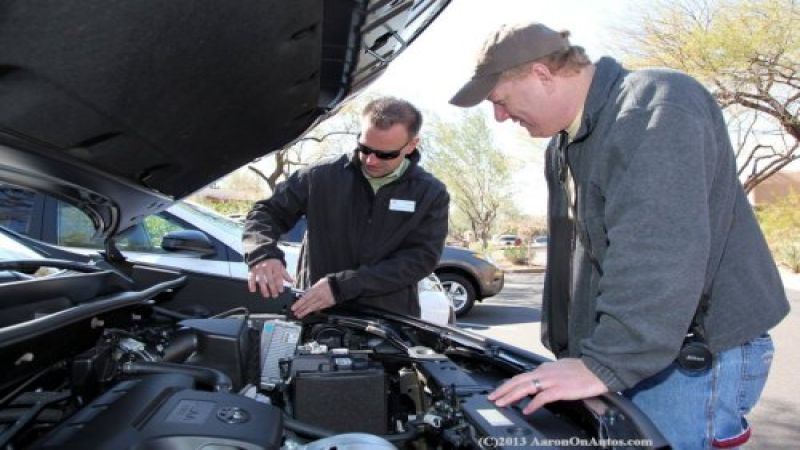One of the top selling compact sport utilities of all time, the Toyota RAV4 has definitely found its place in the automotive market. With the release of the all-new 2013 model, the RAV4 continues to cater to the small family segment. Although most of the attention is on its style and handling, Toyota is also well-known for their attention to detail in the engine compartment, making life a lot easier for the DIY mechanic. If you maintain your own vehicles, then you'll be interested to know that Toyota hasn't forgotten you despite all of the technological advances over the past few years.
The fourth generation RAV4 delivers a lot of excellence in this latest rendition, pushing to keep this very competitive market segment on its toes. During the SUV's press reveal in Phoenix, Arizona last week, Don Bain and I spent a lot of time with the new little ute and, grabbing the opportunity presented, I spent over an hour in total with Toyota University's Jeff Halsey (pictured above with the author - I'm the good looking one, he's the one in glasses) discussing the innards of the 2013 RAV4.
The heart of the RAV4's impressive get-up-and-go is an all-aluminum 2.5-liter dual overhead cam (DOHC) 16-valve, 4-cylinder engine with Dual VVT-i (variable valve timing with intelligence). This little engine puts out 176 horsepower at 6,000 rpm and 172 lb-ft of torque at 4,100 rpm. It's as top of the line as any low-cost, fuel efficient, high-output four cylinder engine can be.
It's mounted sideways for front-wheel-drive configuration (the 2013 RAV4 offers FWD and AWD), with the manifold towards the front of the vehicle and the accessories to the passenger's side. The plastic top cover, which protects the spark plugs and their solenoids, pulls off without any tool required to reveal those plugs. This gives full access to everything the DIY mechanic needs for routine maintenance.
The Spark plugs are in-line right across the top of the engine, easily accessed. Behind them, just below the top of the intake, is the fuel rail and injectors. The oil filler cap sits just behind the manifold on top of the engine.
The oil filter is of the new cartridge type and easily accessed from underneath the RAV4, situated just behind the air damper slightly to the passenger's side, off-center. The drain plug is at center, not far from that cartridge. This setup means that oil and filter changes, plug changes, and the like are easily done without special tools and without having to lift the SUV or remove anything to access these points.
Other engine fluids have their reservoirs readily-accessible from under the hood with long necks and clear bottles so you can easily see, at a glance, what state they're in.
The serpentine (accessory) belt is at the front of the engine (facing the passenger's side fender). While it will require a little more effort to change, the alternator sits directly in your line of sight as you look down and can be loosened and pushed down without removing anything to access the bolts. The belt can then be slipped off and replaced with a little wiggling, but should come off and go back on unencumbered.
Given how well-tuned the 2013 RAV4 is for DIY maintenance, much like the Prius c I talked about last year, it is definitely in keeping with the Toyota tradition of engineering for easy upkeep.
Of course, if you buy a 2013 RAV4, you won't need to worry about this for at least two years. Toyota is including, as standard, two years of comprehensive maintenance and service on these SUVs with all new purchases.











Comments
Glad you've got this angle
Permalink
Glad you've got this angle covered, amigo. I used to work on my own cars changing fuel filters, water pumps, alternators and the like, but just wearied of it. That's one of the things I like about driving media cars - you don't have to muck with them.
Then of course there was the time I had to change a tire on a new Golf at night on a highway siding. They don't have lug nuts - they have lug bolts. Nothing like a heavy, well nigh impossible to align brain teaser when cars are whizzing by at 75 mph.
That experience was enough DIY to last me through this decade at least!
I guess that would do it.
Permalink
In reply to Glad you've got this angle by Don Bain
I guess that would do it. Try it in a big rig. :)
I usually take media cars down to a friend's shop and put them on a lift to get a good look. It's usually amusing to hear some of the reactions of the garage mechanics when they join in for a look. Stuff like "Wow, good idea" but usually things along the lines of "What kind of drunken moron designed that?" haha